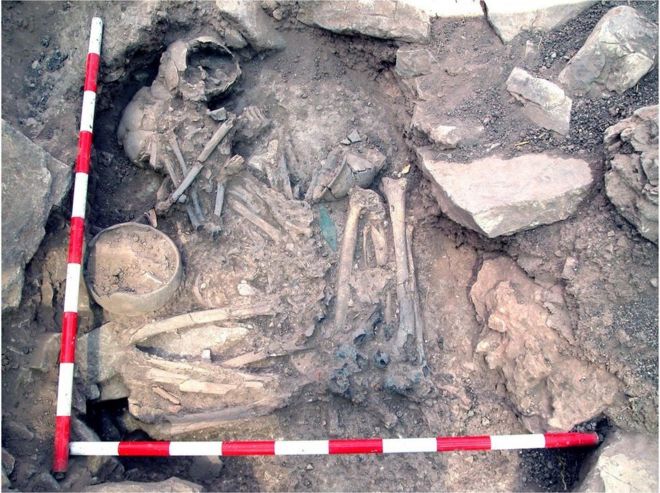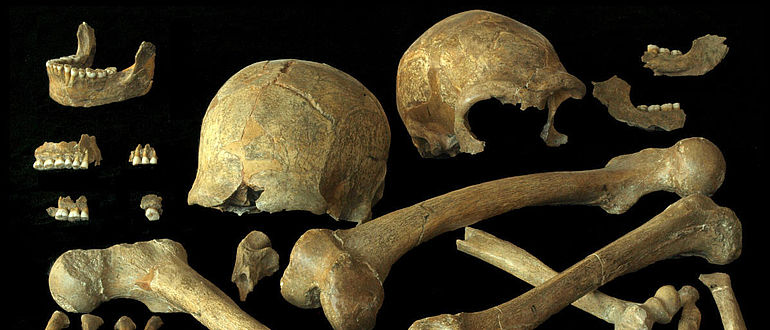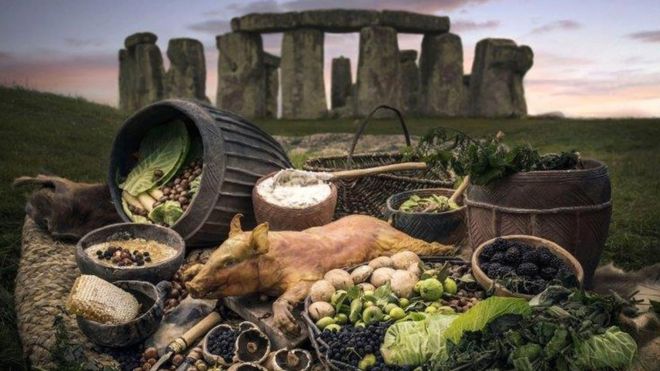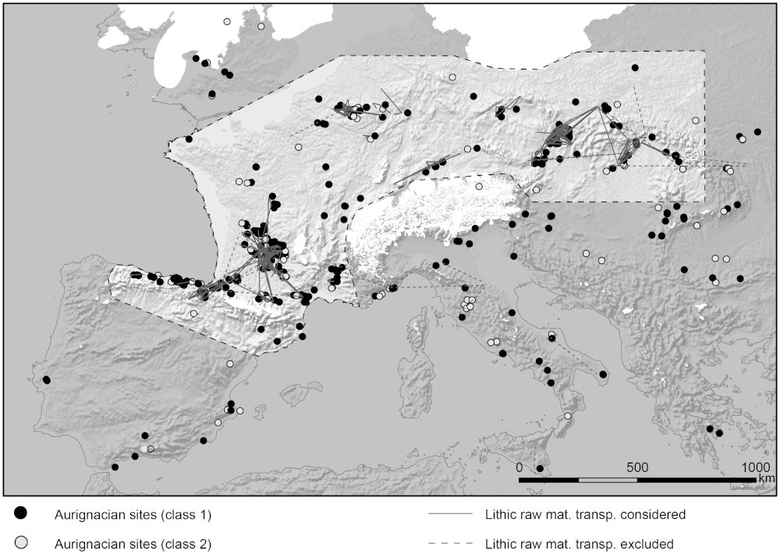The Prehistoric Archaeology Blog is concerned with news reports featuring Prehistoric period archaeology. If you wish to see news reports for general European archaeology, please go to The Archaeology of Europe Weblog.
Monday, March 18, 2019
Archaeologists discovered a flintstone workshop of Neanderthals in the southern Poland; it is approx. 60,000 years old
Researchers discovered a flint workshop of Neanderthals in Pietraszyno (Silesia). According to scientists, it is the first such large workshop in Central Europe that was not located in a cave. So far, researchers have counted 17,000 stone products created 60 thousand years ago.
Neandertals (Homo neanderthalensis) were very close relatives of contemporary man (Homo sapiens). They probably appeared in Poland approximately 300,000 years ago. The oldest stone tools they used, discovered on the Vistula, are over 200,000 years old, and the remains are over 100,000 years old.
"On the bank of the river in Pietraszyno, we discovered an unprecedented amount of flint products - 17,000 - abandoned by Neanderthals approximately 60,000 years ago" - says Dr. Andrzej Wiśniewski from the Institute of Archaeology, University of Wrocław. Since 2018, the researcher has been conducting joint excavations with researchers from the Max Planck Institute for Evolutionary Anthropology in Leipzig in the framework of a National Science Centre project. In his opinion, this is the first such large Neandertal workshop discovered in Central Europe that was not located in a cave.
Read the rest of this article...
Ancient switch to soft food gave us an overbite—and the ability to pronounce ‘f’s and ‘v’s
An ancient woman from Romania shows an edgeto-edge bite (left). A Bronze Age man from Austria had a slight overbite (right). D. E. BLASI ET AL., SCIENCE, 363, 1192 (2019)
Don't like the F-word? Blame farmers and soft food. When humans switched to processed foods after the spread of agriculture, they put less wear and tear on their teeth. That changed the growth of their jaws, giving adults the overbites normal in children. Within a few thousand years, those slight overbites made it easy for people in farming cultures to fire off sounds like "f" and "v," opening a world of new words.
The newly favored consonants, known as labiodentals, helped spur the diversification of languages in Europe and Asia at least 4000 years ago; they led to such changes as the replacement of the Proto-Indo-European patēr to Old English faeder about 1500 years ago, according to linguist and senior author Balthasar Bickel at the University of Zurich in Switzerland. The paper shows "that a cultural shift can change our biology in such a way that it affects our language," says evolutionary morphologist Noreen Von Cramon-Taubadel of the University at Buffalo, part of the State University of New York system, who was not part of the study.
Read the rest of this article...
Ancient migration transformed Spain's DNA
Bronze Age burials: Iberia saw a dramatic genetic shift during this period
L BENITEZ DE LUGO ENRICH - JOSE LUIS FUENTES SANCH
A migration from Central Europe transformed the genetic make-up of people in Spain during the Bronze Age, a study reveals.
DNA evidence shows the migrants streamed over the Pyrenees, replacing existing male lineages across the region within a space of 400 years.
It remains unclear whether violence played a role or whether a male-centric social structure was more important.
The result comes from the most extensive study of its kind.
Researchers reconstructed the population history of Iberia (modern Spain, Portugal, Gibraltar and Andorra) over 8,000 years - the biggest slice of time tackled by a single ancient DNA study. The region has been a crossroads for different cultures over time.
Read the rest of this article...
Neandertaler und moderne Menschen hatten ähnliche Speisezettel
Knochen aus Spy geben Aufschluss über Ernährung und Mobilität der dortigen Neandertaler. Foto: Royal Belgian Institute of Natural Sciences (RBINS)
Internationale Studie findet mehr gemeinsame Nahrungsvorlieben als angenommen ‒ Rätselhafte Spuren von Kannibalismus
Neandertaler und der frühe moderne Mensch ernährten sich vermutlich sehr ähnlich: Zu diesem Schluss kommt eine internationale Studie und widerspricht damit der Annahme, die Neandertaler seien ausgestorben, weil ihr Ernährungsspektrum eingeschränkt war. Die Ergebnisse zeigten aber auch, dass moderne Menschen dennoch einen Vorteil hatten, weil sie vermutlich mobiler und besser vernetzt waren, berichtet das Team um Dr. Christoph Wißing von der Universität Tübingen.
Read the rest of this article...
Thursday, March 14, 2019
Hominids may have hunted rabbits as far back as 400,000 years ago
BUNNY TRAIL Fossils from southern European sites indicate that ancient relatives of humans hunted small, fast animals as early as around 400,000 years ago. Ends of rabbit bones (shown) were probably snapped off to remove marrow.
In Europe, Stone Age hominids began adding small, fast animals to their menus much earlier than previously thought, scientists say.
Now-extinct members of the human genus, Homo, hunted rabbits and, to a lesser extent, hares in southern France and probably other Mediterranean parts of Europe by around 400,000 years ago, researchers report online March 6 in Science Advances. Hunters also bagged larger creatures such as wild goats and deer. The new finding may highlight the flexibility and innovativeness of these ancient relatives of humans.
That dietary shift to smaller animals away from eating primarily large game emerged long before a previously recognized change in ancient humans’ eating habits, concludes a team led by paleoanthropologist Eugène Morin of Trent University in Peterborough, Canada. In the later transition, Stone Age people dramatically broadened what they ate, including a wide variety of small animals, starting around 36,000 years ago.
Read the rest of this article...
Researchers find a piece of Palaeolithic art featuring birds and humans
A tracing of the engraved figures over the stone [Credit: University of Barcelona]
It is not very common to find representations of scenes instead of individual figures in Palaeolithic art, but it is even harder for these figures to be birds instead of mammals such as goats, deer or horses. So far, historians have only found three scenes of Palaeolithic art featuring humans and birds in Europe.
Now, an article published in the journal L'Anthropologie tells how University of Barcelona researchers found -in the site of Hort de la Bequera (Margalef de Montsant, Priorat)-, an artistic piece from 12,500 years ago in which humans and birds try to interact in a pictorial scene with exceptional traits: figures seem to star a narration on hunting and motherhood.
Regarding the Catalan context in particular, this is an important finding regarding the few pieces of Palaeolithic art in Catalonia and it places this territory within the stream of artistic production of the upper Palaeolithic in the Mediterranean.
Read the rest of this article...
Stonehenge was 'hub for Britain's earliest mass parties'
Pigs were the main food at the feasts and were brought from as far away as Scotland and the North East of England to Stonehenge
ENGLISH HERITAGE/PA
Evidence of large-scale prehistoric feasting rituals found at Stonehenge could be the earliest mass celebrations in Britain, say archaeologists.
The study examined 131 pigs' bones at four Late Neolithic sites, Durrington Walls, Marden, Mount Pleasant and West Kennet Palisade Enclosures.
The sites, which served Stonehenge and Avebury, hosted the feasts.
Researchers think guests had to bring meat raised locally to them, resulting in pigs arriving from distant places.
Read the rest of this article...
HABITATS DE L’ÂGE DU BRONZE, SILOS ET RITUELS GAULOIS À FAUX-FRESNAY
À Faux-Fresnay, dans la Marne, une équipe d’archéologues de l’Inrap a découvert des vestiges de deux villages de l’âge du Bronze et de l’âge du Fer qui témoignent d’une importante activité agricole. Des silos où reposent des restes d’animaux interrogent sur des rituels qui auraient impliqué le cheptel. Cette fouille est réalisée en amont de l’aménagement d’un poste électrique par RTE.
Read the rest of this article...
In Europa lebten im frühen Jungpaläolithikum im Schnitt nur 1.500 Menschen
Mit einem an der Universität zu Köln entwickelten Protokoll können die Forscherinnen und Forscher des Sonderforschungsbereiches 806 "Our Way to Europe" rekonstruieren, wie die Besiedlung Europas durch den anatomisch modernen Menschen verlief. Die Daten zeigen, dass die Population der gesamten europäischen Jäger und Sammler in der Zeitspanne von etwa 42.000 bis etwa 33.000 Jahren vor heute – dem sogenannten Aurignacien – durchschnittlich nur etwa 1.500 Personen betrug.
Read the rest of this article...
Tuesday, March 12, 2019
'Hobbit' human story gets a twist, thanks to thousands of rat bones
The limestone cave of Liang Bua, on the Indonesian island of Flores, is widely known as the hobbit cave, the site where the surprisingly tiny and enormously controversial extinct human relative Homo floresiensis was discovered. But to the scientists who excavate there, the site is known as something else entirely: the rat cave.
“The first time I went to the excavations at Liang Bua, I remember watching the bones coming out of the ground and being amazed at how it was almost all rat,” recalls Matthew Tocheri, the Canada Research Chair in Human Origins at Lakehead University.
Subscribe to:
Posts (Atom)









